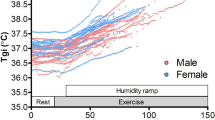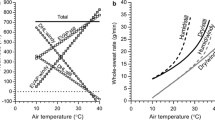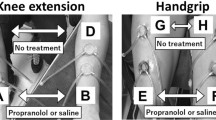Abstract
We evaluated the hypothesis that females would show a greater postexercise hypotension and concurrently a greater increase in the onset threshold for sweating. Fourteen subjects (7 males and 7 females) of similar age, body composition, and fitness status participated in the study. Esophageal temperature was monitored as an index of core temperature while sweat rate was measured by using a ventilated capsule placed on the upper back. Subjects cycled at either 60% (moderate) or 80% (intense) of peak oxygen consumption \( {\left( {\ifmmode\expandafter\dot\else\expandafter\.\fi{V}{\text{O}}_{{2{\text{peak}}}} } \right)} \) followed by 20-min recovery. Subjects then donned a liquid-conditioned suit used to regulate mean skin temperature. The skin was then heated (∼4.3°C·h−1) until sweating occurred. Esophageal temperatures were similar to baseline before the start of whole body warming for all conditions. The postexercise threshold values for sweating following moderate and intense exercise were an esophageal temperature increase of 0.10 ± 0.02 and 0.22 ± 0.04°C, respectively for males, and 0.15 ± 0.03 and 0.34 ± 0.01°C, respectively for females. All were elevated above baseline resting (P < 0.05) and a significant sex-related difference was observed for sweating threshold values following intense exercise (P < 0.05). This was paralleled by a greater decrease in mean arterial pressure in females at the end of the 20-min recovery (P < 0.05). In conclusion, females demonstrate a greater postexercise onset threshold for sweating, which is paralleled by a greater postexercise hypotensive response following intense exercise.

Similar content being viewed by others
References
Carter R III, Watenpaugh DE, Smith ML (2001) Gender differences in cardiovasculalr regulation during recovery from exercise. J Appl Physiol 91:1902–1907
Carter R III, Wilson TE, Watenpaugh DE, Smith ML, Crandall CG (2002) Effects of mode of exercise recovery on thermoregulatory and cardiovascular responses. J Appl Physiol 93:1918–1924
Fisher M, Paolone V, Rosene J, Drury D, Van Dyke A, Moroney D (1999) The effect of submaximal exercise on recovery hemodynamics and thermoregulation in men and women. Res Q Exerc Sport 70:361–368
Fortney SM, Wenger CB, Bove JR, Nadel ER (1984) Effect of hyperosmolality on control of blood flow and sweating. J Appl Physiol. 57:1688–1695
Frascarolo P, Schutz Y, Jequier E (1992) Influence of the menstrual cycle on the sweating response measured by direct calorimetry in women exposed to warm environmental conditions. Eur J Appl Physiol Occup Physiol 64:449–454
Frye AJ, Kamon E (1981) Responses to dry heat of men and women with similar aerobic capacities. J Appl Physiol 50:65–70
Gisolfi C, Robinson S (1970) Central and peripheral stimuli regulating sweating during intermittent work in men. J Appl Physiol 29:761–768
Halliwill JR (2001) Mechanisms and clinical implications of post-exercise hypotension in humans. Exerc Sport Sci Rev 29:65–70
Havenith G (2001) Individualized model of human thermoregulation for the simulation of heat stress response. J Appl Physiol 90:1943–1954
Inoue Y, Tanaka Y, Omori K, Kuwahara T, Ogura Y, Ueda H (2005) Sex- and menstrual cycle-related differences in sweating and cutaneous blood flow in response to passive heat exposure. Eur J Appl Physiol 94:323–332
Jonhson JM and Proppe DW (1996) Cardiovascular adjustments to heat stress. In: Handbook of physiology. environmental physiology. American Physiological Society, Bethesda, pp 215–243
Journeay WS, Reardon FD, Jean-Gilles S, Martin CR, Kenny GP (2004a) Lower body positive and negative pressure alter thermal and hemodynamic responses after exercise. Aviat Space Environ Med 75:841–849
Journeay WS, Reardon FD, Martin CR, Kenny GP (2004b) Control of cutaneous vascular conductance and sweating during recovery from dynamic exercise in humans. J Appl Physiol 96:2207–2212
Journeay WS, Reardon FD, McInnis NH, Kenny GP (2005) Nonthermoregulatory control of cutaneous vascular conductance and sweating during recovery from dynamic exercise in women. J Appl Physiol 99:1816–1821
Kaciuba-Uscilko H, Grucza R (2001) Gender differences in thermoregulation. Curr Opin Clin Nutr Metab Care 4:533–536
Kenny GP, Jay O (2007) Sex differences in postexercise esophageal and muscle tissue temperature response. Am J Physiol Regul Integr Comp Physiol 292:R1632–R1640
Kenny GP, Chen AA, Johnston CE, Thoden JS, Giesbrecht GG (1997) Intense exercise increases the post-exercise threshold for sweating. Eur J Appl Physiol Occup Physiol 76:116–121
Kenny GP, Periard J, Journeay WS, Sigal RJ, Reardon FD (2003) Effect of exercise intensity on the postexercise sweating threshold. J Appl Physiol 95:2355–2360
Kenny GP, Jay O, Zaleski W, Reardon ML, Sigal RJ, Journeay WS, Reardon FD (2006a) Postexercise hypotension causes a prolonged perturbation in esophageal and active muscle temperature recovery. Am J Physiol Regul Integr Comp Physiol 291:R580–R588
Kenny GP, Murrin JE, Journeay WS, Reardon FD (2006b) Differences in the postexercise threshold for cutaneous active vasodilation between men and women. Am J Physiol Regul Integr Comp Physiol 290:R172–R179
Kilgour RD, Gariepy P, Rehel R (1993) Cardiovascular responses during recovery from exercise and thermal stress. Aviat Space Environ Med 64:224–229
Mack G, Nishiyasu T, Shi X (1995) Baroreceptor modulation of cutaneous vasodilator and sudomotor responses to thermal stress in humans. J Physiol 483:537–547
Nadel ER, Mitchell JW, Saltin B, Stolwijk JA (1971) Peripheral modifications to the central drive for sweating. J Appl Physiol 31:828–833
Piepoli M, Coats AJ, Adamopoulos S, Bernardi L, Feng YH, Conway J, Sleight P (1993) Persistent peripheral vasodilation and sympathetic activity in hypotension after maximal exercise. J Appl Physiol 75:1807–1814
Piepoli M, Isea JE, Pannarale G, Adamopoulos S, Sleight P, Coats AJ (1994) Load dependence of changes in forearm and peripheral vascular resistance after acute leg exercise in man. J Physiol 478(Pt 2):357–362
Senitko AN, Charkoudian N, Halliwill JR (2002) Influence of endurance exercise training status and gender on postexercise hypotension. J Appl Physiol 92:2368–2374
Shibasaki M, Kondo N, Crandall CG (2003) Non-thermoregulatory modulation of sweating in humans. Exerc Sport Sci Rev 31:34–39
Shibasaki M, Sakai M, Oda M, Crandall CG (2004) Muscle mechanoreceptor modulation of sweat rate during recovery from moderate exercise. J Appl Physiol 96:2115–2119
Stephenson LA, Kolka MA (1993) Thermoregulation in women. Exerc Sport Sci Rev 21:231–262
Tarnopolsky M (1999) Hormonal differences. In: Gender differences on metabolism, CRC, Boca Raton, pp 1–30
Wilson TE, Carter III R, Cutler MJ, Cui J, Smith ML, Crandall CG (2004) Active recovery attenuates the fall in sweat rate but not cutaneous vascular conductance following supine exercise. J Appl Physiol 96:668–673
Acknowledgments
This research was supported by a Discovery Grant from the Natural Sciences and Engineering Research Council of Canada (Grant held by Dr. Glen P. Kenny).
Author information
Authors and Affiliations
Corresponding author
Rights and permissions
About this article
Cite this article
Kenny, G.P., Jay, O. Evidence of a greater onset threshold for sweating in females following intense exercise. Eur J Appl Physiol 101, 487–493 (2007). https://doi.org/10.1007/s00421-007-0525-5
Accepted:
Published:
Issue Date:
DOI: https://doi.org/10.1007/s00421-007-0525-5




